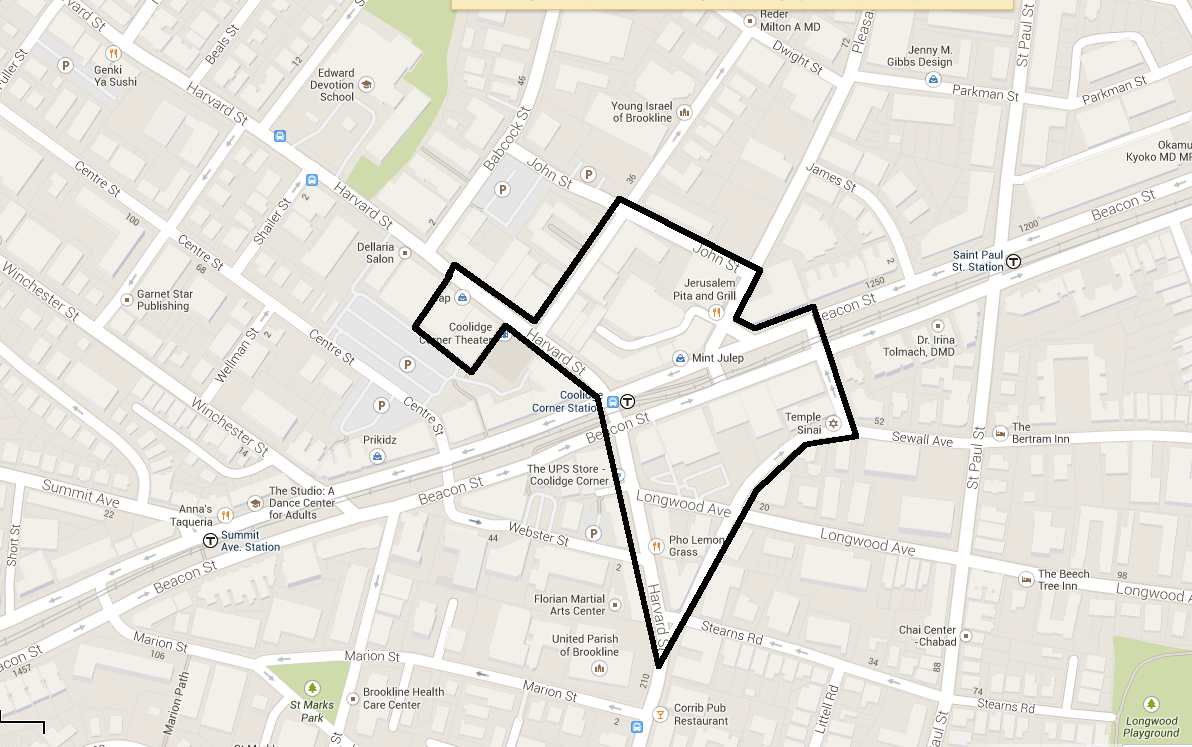
Exploring cities and buildings has been a passion of mine for as long as I can remember. The Boston area is riveting, infinitely different from my home town in north Texas and brimming with potential sites to study. Still, I decided to return to the very beginning and choose a place I had visited during my first trip to the Northeast: Coolidge Corner.
As a suburbanite from the South, I am particularly fascinated by Boston’s intricate public transportation system and, more specifically, how it affected the development of cities in the Greater Boston region. Coolidge Corner hails at the intersection of Harvard Street and Beacon Street and is anchored to Boston by the Green Line, making it a perfect case to study this idea. Though I had visited this neighborhood of Brookline only twice before, its distinct atmosphere left a memorable impression.
Upon arriving at the T-Stop, you are thrown straight into the heart of the excitement. You find yourself in the middle of an extended intersection where the railway is outlined first by sidewalk then by street. At first glance, everything is bustling with movement. You are surrounded by four corners, each with a store front facing the center of the intersection. Harvard Street extends to the northwest and south, lined with a nearly homogenous assortment of independently owned shops and commercial franchises.
Each corner possesses its own character and reads as a mishmash of random building styles and colors. Inhabiting one corner, for example, is a clock tower attached to a cream colored building with dark brown trim that creates patterns reminiscent of a barn. This building, so out of place, so notably significant and impossible to miss, is now home to a Walgreens. What was the original intention for this landmark and what could have happened to cause this ornate structure to become nothing more than a chain pharmacy?
Another landmark seen from the subway station is the movie theater. Unlike the clock tower, this has retained its original function. The theater is charming and clearly historic; its bright neon sign breaks the line of soft amber street lamps on the main road. How was the theater affected by the arrival of new businesses over the decades?
Across from the theater, Green Street branches off to the northeast. Restaurants line the intersection, but as you venture further, the whole scene drastically shifts. After a couple steps, you find you are no longer in a commercial area but rather in a quiet, residential district. The lights dim and the noises muffle. There are large mansions broken up into apartments housing multiple occupants, as evidenced by the many mailboxes at the front door. Did these surrounding inhabitants immigrate to the area as a result of Coolidge Corner’s commercial growth or were they the driving force behind the development?
Traveling south on Pleasant Street and then southwest on Sewall Avenue, you encounter, as Grady Clay describes, a “break” in the grid of the area.¹ This street marks one side of a triangular block found directly south of the T-stop. This break, however, is not clean; it is not a point where only two grids clash but rather where multiple irregularities occur. There appears to be no underlying reason behind the placement and shape of the streets. Which streets were made first and what did they originally want to connect? Was Harvard Street one of the primary paths? To what extent did the introduction of the Green Line cause the grid to fracture?
Coolidge Corner sparked my curiosity. It has compelling features of a commercial district but an inviting small town feel. I placed the boundaries as to enclose all the anomalies that I believe make this space so mesmerizing.
Bibliography
Clay, Grady. Close-Up: How to Read the American City. The University of Chicago Press: Chicago, IL. 1980: pp. 11-16, 38-65.
Figure 1: Brookline, MA. (17 February 2014). Google Maps. Google. Retrieved from https://maps.google.com/maps?ct=reset&tab=ll